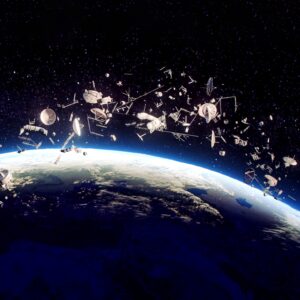Amidst our celebrations of launching tons of rockets, satellites, and space missions beyond the Earth’s atmosphere, there is a crucial matter that often goes unspoken: the growing threat of space debris, which is not only wasteful but is dangerous to human life.
Focusing specifically on the Moon, there are nearly 100 bags of human waste left behind on this celestial body, and with more countries planning to explore the moon, this number will grow.
As we continue to explore the space, we are creating a mess owing to thousands of dead satellites orbiting our planet. This situation demands our immediate attention, for it has the potential to evolve into a formidable threat in the future.
What is Space Debris?
Space debris is pieces of machinery and debris left by humans in space. It can refer to big objects like a dead satellite or paint flecks fallen from a rocket. There are almost 3,000 dead satellites floating around in space.
Types Of Space Debris
- Payload – These are mainly satellites and include fragments produced by wear and tear and collisions.
- Rockets – They are leftover parts from the rockets that put satellites into space.
- Mission related-objects – These are things like tools, screws, cables, and cameras that astronauts might have accidentally let go of during their missions.
Causes Of Space Debris

-
Defunct Satellites
Satellites have a limited lifespan. When they stop working, they can become space debris. Instead of falling back to Earth, many of these dead satellites stay in space, especially those in higher orbits.
-
Missing Equipment
Astronauts working in space sometimes accidentally let go of tools or objects during their spacewalks. These objects can turn into space debris. For example, in 2008, an astronaut Heidemarie Stefanyshyn-Pierre dropped a box of tools. The box disintegrated a year later when it entered the Earth’s atmosphere.
-
Rocket Stages
When rockets launch satellites into space, they have multiple stages. Some of these rocket stages are left behind in lower orbits and can become space debris. In higher orbits, these stages can explode because of leftover rocket fuel, creating smaller fragments that add to the debris in space.
What Are The Solutions?
Let’s talk about the solutions now.
-
NASA’s Space Bag
NASA is working with TransAstra to build specialised inflatable bags that can collect and transport space debris back to Earth. These bags come in different shapes and sizes and are designed to capture everything from small defunct satellites to large rocket bodies. The bag attaches to a spacecraft, and once it’s filled with debris, the spacecraft uses a propulsion system to bring it back to Earth.
However, according to TransAstra’s CEO Jeol Sercel, the bag needs to match the speed of the debris and undertake precision manoeuvres ‘to open the bag, get the bag around the debris and then close the bag.’
-
Giant Lasers
High-powered plasma lasers on Earth could be used to slow down space debris, allowing it to re-enter Earth’s atmosphere and either burn up or fall into the ocean. This approach is called Laser Orbital Debris Removal (LODR), but one challenge is that it might create additional pollution in the oceans.
-
Space Balloons
The Gossamer Orbit Lowering Device or GOLD) system uses an ultra-thin balloon, which is inflated with gas to the size of a football field and attached to large pieces of debris. The balloon then increases the drag of objects enough so that the space junk enters the Earth’s atmosphere and burns up. This system could potentially reduce the time it takes for debris to re-enter from years to months.
-
Self-Destructing Jaintor Satellites
Swiss researchers at the Federal Institute of Technology have developed small satellites called CleanSpace One, equipped with jelly-like tentacles that can grab onto space debris. These satellites then re-enter Earth’s atmosphere along with the debris, burning up in the process.
-
Space Garbage Trucks
The US Defense Advanced Research Project Agency (DARPA) is working on the Electrodynamic Debris Eliminator (EDDE), often referred to as a “space garbage truck.” EDDE has 200 nets that can extend to capture debris. It could fling the junk back to Earth or push the objects together in a closer orbit to not harm the existing satellites.
-
Recycling Satellites
DRAPA’s Phoneix program aims to create a technology that will harvest valuable components from the satellites in their ‘graveyard’ orbits.
-
Space Pods
Russia space corporation Energia is planning to build space pods to knock junk out of orbit and back towards Earth. The space pod uses a nuclear power core to keep itself fueled for 15 years. And during that time, it would knock the defunct satellites out of orbit towards Earth. According to the company representative, they could clean up the space around Earth in ten years by collecting almost 600 dead satellites.
India’s Contribution To Remove The Space Debris
On March 7, 2023, ISRO successfully carried out a controlled re-entry of its decommissioned Megha-Tropiques-1 (MT-1) satellite. The satellite was launched a decade ago to study clouds in the tropical region. When the satellite reached the end of its operational life, ISRO did a controlled re-entry of the satellite to reduce space debris in the Low Earth Orbit (LEO).
In 2022, ISRO inaugurated the world’s first-ever facility that is dedicated to monitoring space debris and safeguarding assets in space, that is expected to help combat the growing threat of orbiting satellites and space stations. The ISRO’s System for Safe and Sustainable Space Operations and Management (IS4OM) would create data from various satellites to detect space objects and avoid collision with them, hence avoiding more pilling of space junk. According to ISRO’s Chairman S Somnath, the facility will eventually work towards creating a system that will help remove space debris. ISRO is also working on the NETRA (Network for Space Objects Tracking and Analysis Project) for the surveillance and tracking of space debris.
According to the Orbital Debris Quarterly News from NASA, there are now 25,182 pieces of space debris out of which 114 are from Indian space assets- the lowest among the major space-faring countries. Even though it may look less, with the constant space missions of India, there has to be a way to ensure that we do not add more to the space debris.
There is another Bengaluru-based startup named Digantra that plans to send a constellation of 40 satellites that will collect data on the space debris from Earth’s lower orbit. The company had sent out a small shoe-sized satellite to collect information on space weather, including radiation and violent storms. The aim is to protect satellites from getting caught in solar outbursts or violent geomagnetic incidents that can destroy a satellite. The information given by Digantra’s satellite will come to rescues of space companies and make sure they don’t face any major losses due to space junk.
Summing Up
Space exploration gives impetus for the growth of the country’s economy and helps unravel the mysteries of the galaxy. The only downfall is the amount of junk left behind, and each country is responsible for ensuring that the debris is taken care of.



